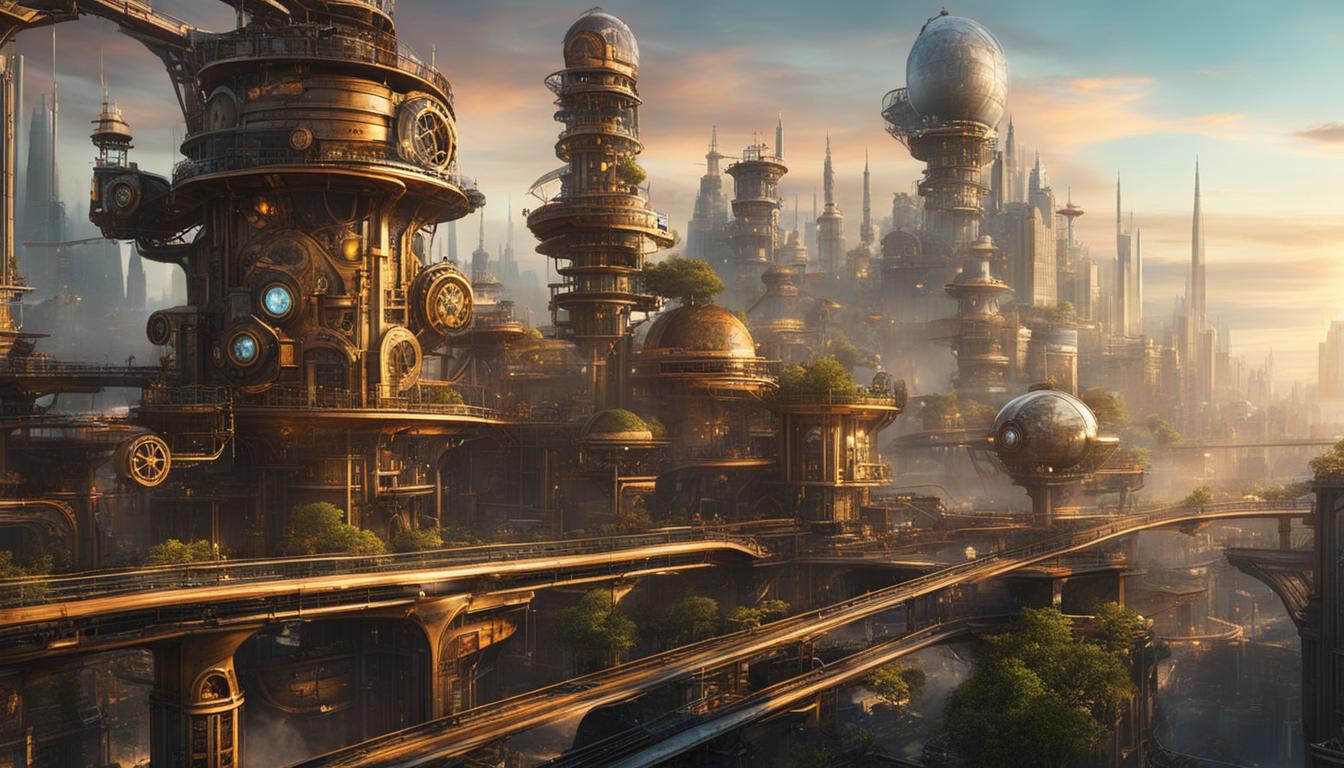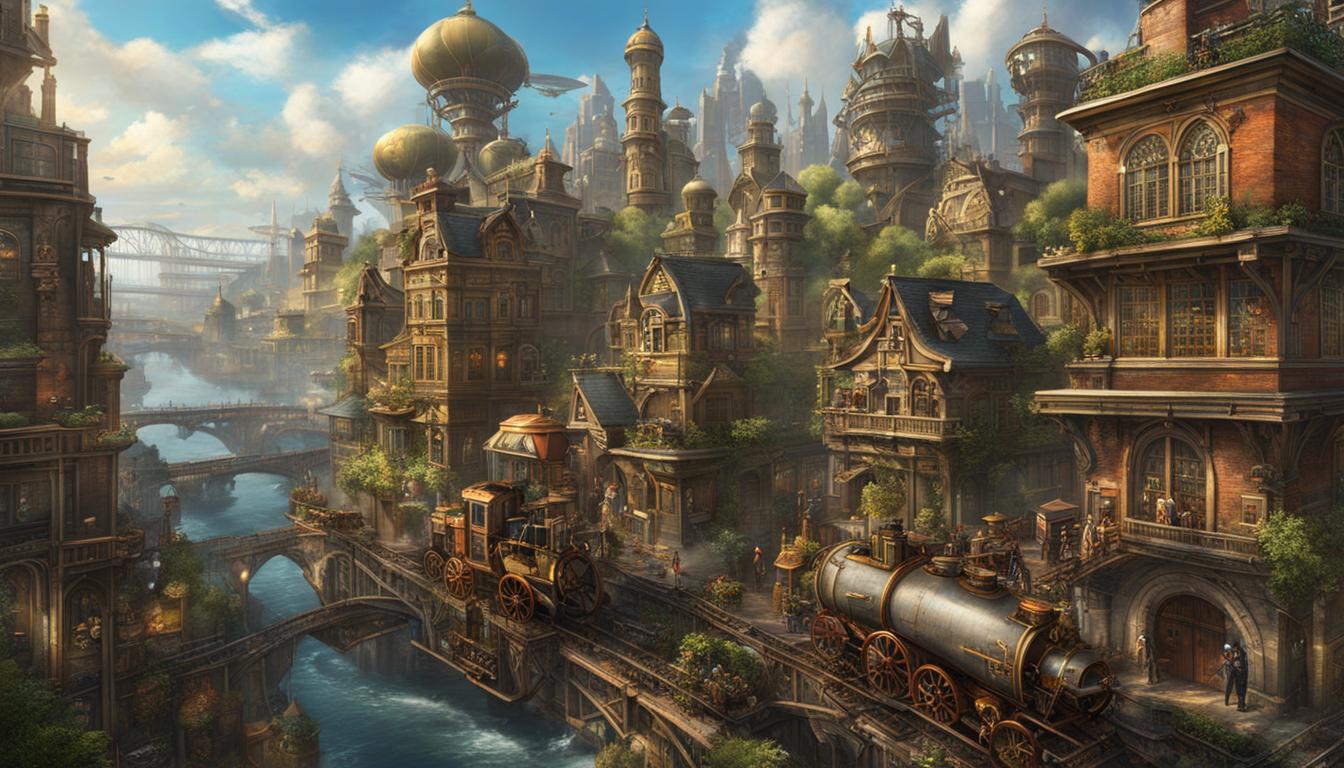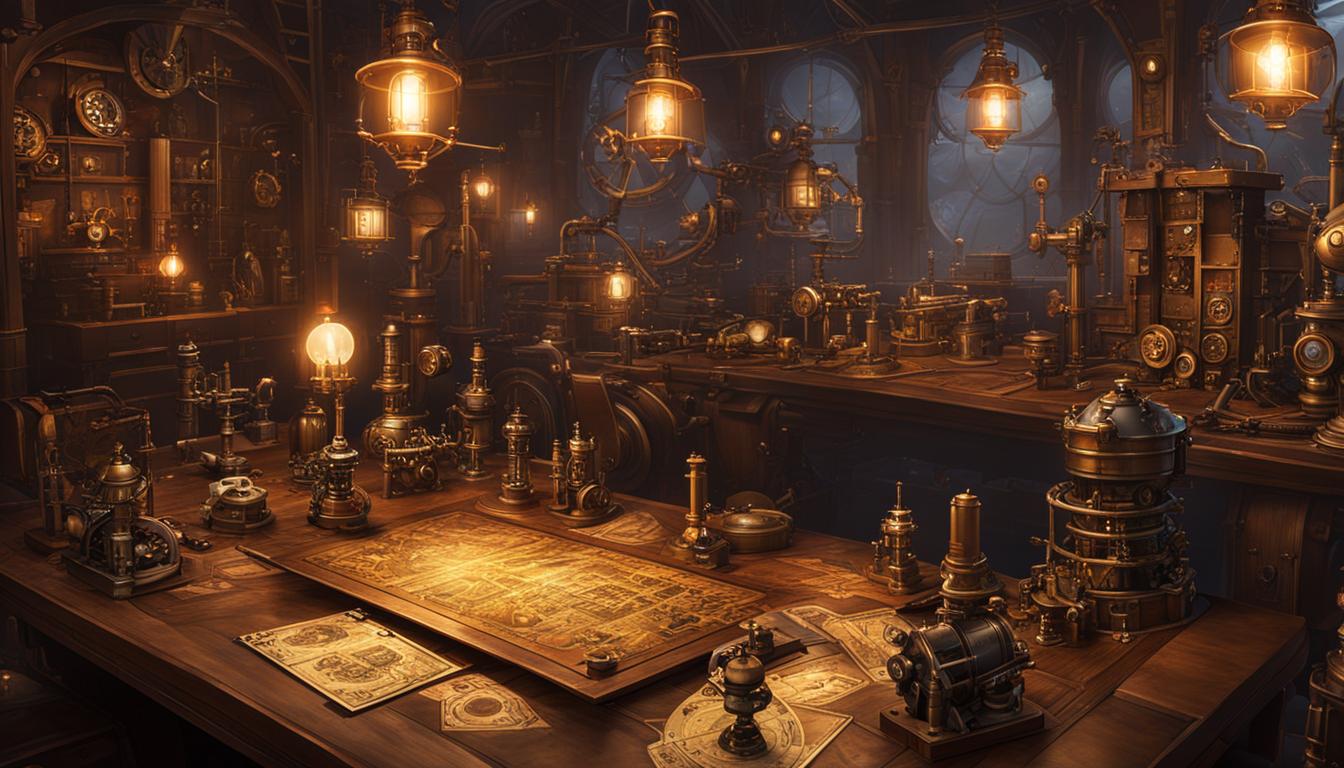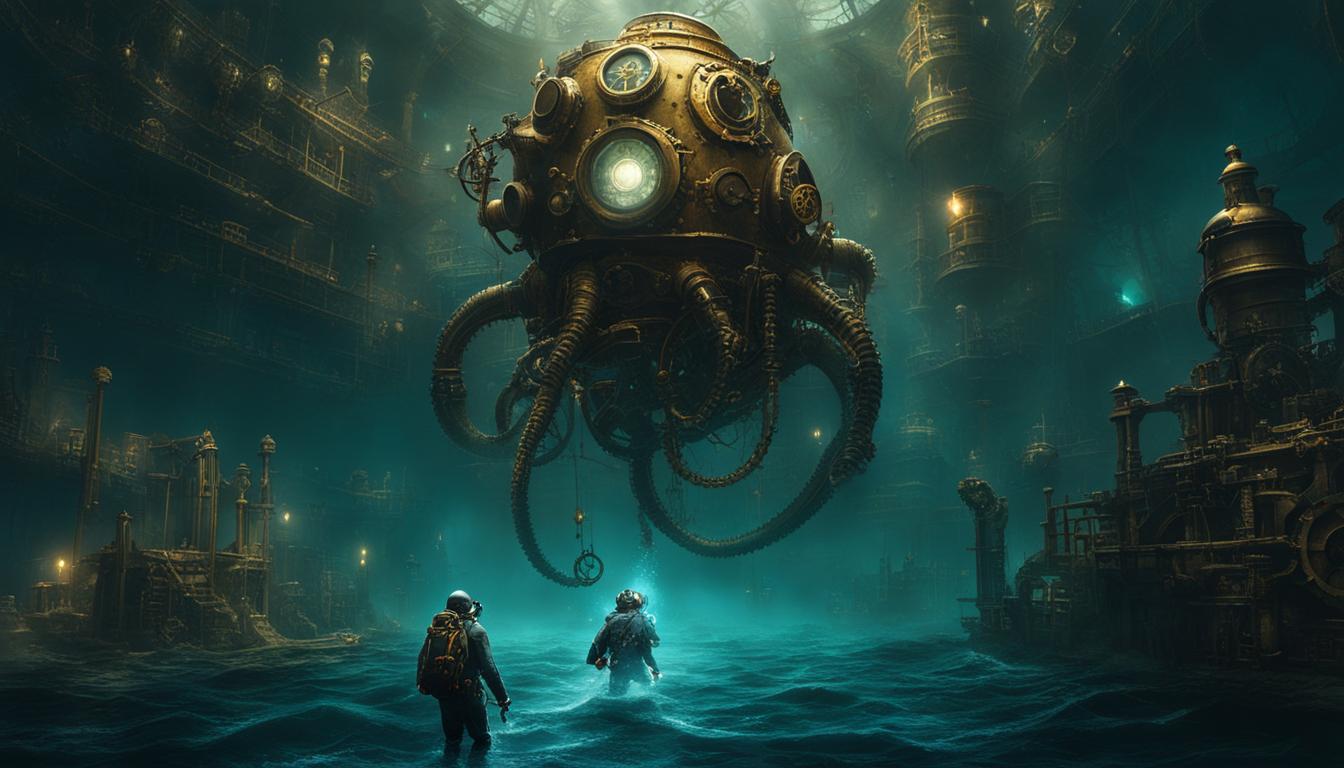Steampunk, a subgenre of science fiction that fuses retro aesthetics with futuristic technology, has begun to make its mark on urban planning. With its unique vision of cities that blend vintage charm with modern sustainability, steampunk offers a refreshing approach to designing the cities of the future.
In steampunk cities, sleek and streamlined designs take center stage, incorporating bold architectural shapes that evoke a sense of futuristic flair. But it’s not all about aesthetics – these cities prioritize functionality and efficiency, integrating smart technologies and automated transportation systems to optimize the flow of people and goods. Additionally, steampunk cities are committed to environmental sustainability, utilizing clean atomic energy and incorporating green spaces into their designs.
Key Takeaways:
- Steampunk cities combine retro aesthetics with futuristic technology.
- These cities prioritize functionality and efficiency.
- Smart technologies and automated transportation systems optimize the flow of people and goods.
- Steampunk cities are committed to environmental sustainability, utilizing clean atomic energy.
- Green spaces are incorporated into the design to enhance the urban environment.
The Look and Feel of Steampunk Cities
Steampunk cities offer a visually captivating experience, combining elements of retro-futuristic aesthetics with sleek design and geometric shapes. These cities transport inhabitants and visitors alike to a world where vintage charm meets futuristic possibilities.
The architecture of steampunk cities is characterized by its sleek and streamlined designs, featuring bold and eye-catching geometric shapes. This unique blend creates a visual spectacle that is both striking and memorable. Glass and steel facades dominate the cityscape, reflecting the interplay between tradition and innovation.
The fashion and culture of steampunk cities also contribute to their distinct look and feel. The city’s residents embrace a style that combines classic 1950s silhouettes with futuristic accents. The result is a vibrant and eclectic fashion scene that adds to the overall energy of the city.
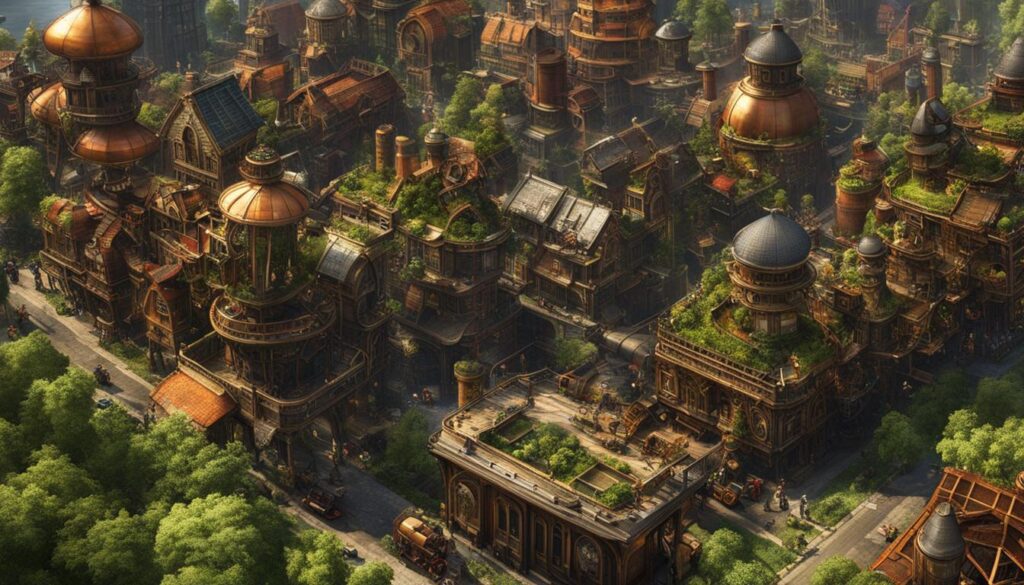
The Intricate Details
“Steampunk cities are a visual feast, creating a world where the past and future intertwine in a symphony of art and imagination.”
Steampunk cities are all about attention to detail. From intricate clockwork mechanisms to elaborate brass fixtures, every aspect of the city’s design is meticulously crafted. These fine details add depth and richness to the overall aesthetic, captivating the senses and immersing visitors in a world of wonder.
A Sense of Adventure
Steampunk cities evoke a sense of adventure and possibility. The neon lights that illuminate the city streets create a vibrant and electrifying atmosphere, drawing people in and inviting them to explore. Each corner of the city holds the promise of new discoveries, whether it’s a hidden steam-powered gadget or a secret underground society.
In conclusion, the look and feel of steampunk cities are a feast for the eyes, combining retro-futuristic aesthetics with sleek design and geometric shapes. From the striking architecture to the eclectic fashion scene, these cities transport inhabitants and visitors to a world where imagination knows no bounds.
Functionality and Efficiency in Steampunk Cities
In the world of steampunk cities, functionality and efficiency are paramount. These cities embrace smart technologies and automated transportation systems to create an urban environment that optimizes the flow of people and goods. Technology plays a vital role in ensuring that these cities operate smoothly and seamlessly.
Automated transportation systems, such as pneumatic tubes and magnetic levitation trains, efficiently move people and goods throughout the city. These systems eliminate the need for traditional vehicles, reducing traffic congestion and improving overall efficiency. Citizens can easily navigate the city using these automated modes of transportation, ensuring a streamlined and efficient experience.
Furthermore, steampunk cities employ smart buildings that utilize advanced sensors and technologies to optimize energy consumption. These buildings can adjust their settings based on occupancy levels, ensuring that energy is used efficiently and minimizing waste. By incorporating smart technologies into their infrastructure, steampunk cities achieve a level of functionality and efficiency that is unparalleled.
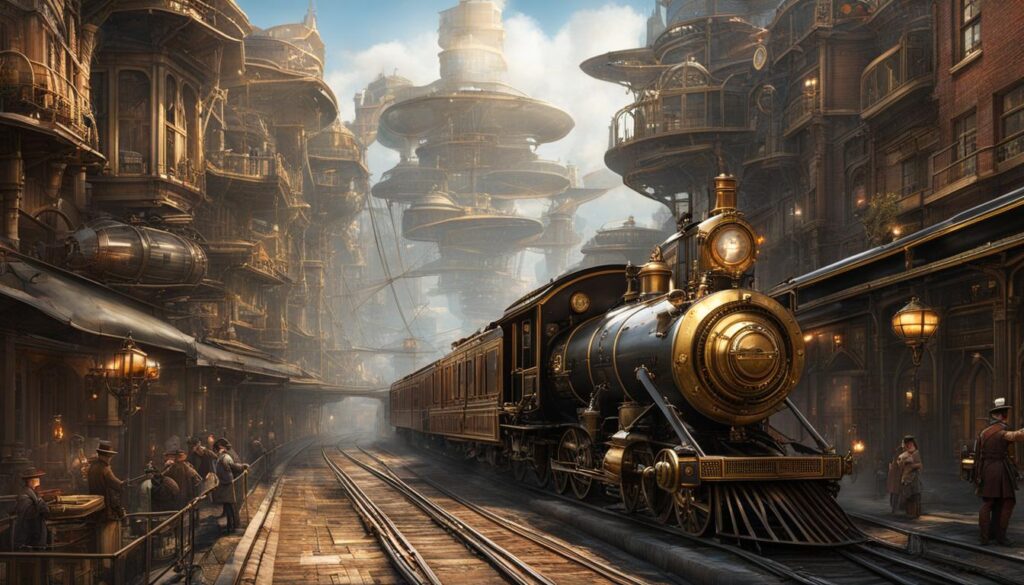
The Role of Smart Technologies
Smart technologies play a crucial role in enhancing the functionality and efficiency of steampunk cities. These technologies enable real-time data collection and analysis, allowing city administrators to make informed decisions about city operations.
“Smart technologies enable steampunk cities to adapt and respond to the needs of their residents in real-time, ensuring that the city functions efficiently while providing a high quality of life.”
For example, smart sensors placed throughout the city monitor traffic patterns, air quality, and energy consumption. This data is then analyzed and used to optimize transportation routes, improve air quality, and identify areas for energy conservation. The integration of smart technologies in steampunk cities creates an environment where resources are used efficiently, resulting in a seamless and sustainable urban experience.
Optimizing the Flow of People and Goods
The layout of steampunk cities is carefully planned to optimize the flow of people and goods. Wide boulevards, efficient transportation systems, and strategically placed commercial centers ensure that citizens and businesses can move and operate smoothly.
- The city’s design includes dedicated pedestrian spaces and bike lanes, encouraging alternative modes of transportation and reducing reliance on cars.
- Commercial and residential districts are strategically located to minimize commuting distances, reducing travel time and congestion.
- Efficient waste management systems are implemented to ensure cleanliness and hygiene while minimizing the environmental impact.
By prioritizing functionality and efficiency in their design and infrastructure, steampunk cities create an urban environment that seamlessly combines technology, smart systems, and optimal flow, resulting in a truly remarkable and sustainable city.
Environmental Sustainability in Steampunk Cities
As the world continues to grapple with environmental challenges, steampunk cities offer a refreshing alternative that marries technology with sustainable practices. At the heart of these imaginative urban landscapes lies the concept of clean atomic energy, powering these cities without compromising the environment. By harnessing the potential of atomic energy, steampunk cities minimize their carbon footprint while providing efficient and reliable power sources.
But it doesn’t stop there. Steampunk cities also embrace the beauty of nature, integrating green spaces into their designs. From sprawling rooftop gardens that capture the essence of a utopian oasis to carefully crafted public parks, these cities prioritize the well-being of their residents and the preservation of the natural world. As towering steel and glass structures mingle with lush vegetation, there is an undeniable harmony between technology and the environment.
Efficient waste management systems are another cornerstone of steampunk cities’ commitment to sustainability. By implementing innovative solutions, these cities strive to minimize waste and reduce their impact on the environment. From automated recycling programs that efficiently sort and process materials to cutting-edge composting methods, every aspect of waste management is carefully considered and optimized.
The Future is Green
In steampunk cities, a brighter, greener future is not just a dream but a tangible reality. As clean atomic energy powers the urban landscape, green spaces thrive, and efficient waste management takes center stage, these cities serve as a testament to what can be achieved when imagination melds with sustainability. Stepping into a steampunk city is like entering a world where technology and nature coexist, inspiring us to reimagine what our own cities could become.
FAQ
How is steampunk incorporated into urban planning?
Steampunk is a subgenre of science fiction that combines retro aesthetics with futuristic technology. It influences urban planning by blending vintage charm with modern sustainability, creating cities with a unique vision.
What are the visual characteristics of steampunk cities?
Steampunk cities feature sleek, streamlined designs, bold architectural shapes, glass and steel facades, and bright neon lights. They combine retro and futuristic elements, creating a visual fusion of the Jetsons and Mad Men.
What is the focus on functionality and efficiency in steampunk cities?
Steampunk cities prioritize functionality and efficiency by incorporating smart technologies and automated transportation systems. The layout is carefully planned to minimize traffic congestion and optimize the flow of people and goods.
How do steampunk cities promote environmental sustainability?
Steampunk cities utilize clean atomic energy as a power source and incorporate green spaces, such as rooftop gardens and public parks. They also implement efficient waste management systems to minimize environmental impact.

